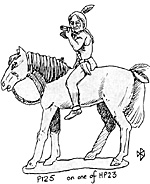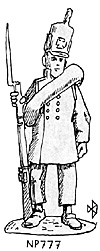 There is a plausible situation when this can be done. When the rule book you wish to use for adjudicating combat doesn't cover other aspects of a wargame. Rule Books can be put into various groupings one of which is that of books written by companies who earn their living from doing so such as the publishers of Newbury Rules and the War Games Research Group. And those published by companies who normally publish works on militaria and transport such as Argos Publications and PSL.
There is a plausible situation when this can be done. When the rule book you wish to use for adjudicating combat doesn't cover other aspects of a wargame. Rule Books can be put into various groupings one of which is that of books written by companies who earn their living from doing so such as the publishers of Newbury Rules and the War Games Research Group. And those published by companies who normally publish works on militaria and transport such as Argos Publications and PSL.
A major feature of these respective rule books is that in the former publishers, Newbury & WRG the rule books cover all aspects of operating a wargame army. The latter usually cover only forward movement and combat, and required use of a more detailed set of rules to provide the extra detail. I currently use a copy of "American Civil Wargaming" by Terence Wise published by Airfix in the 1970's. These allow for very fast adjudication of combat (using the method that X number of figures will kill Y number of figures at Z range).
They do not provide for how long it takes to transform a line into a column or how quickly an ambushed column may react. To cover these omissions I use WRG's 1685 - 1845 rules chiefly for their speed of use.
An implausible? situation for using rules for other periods is that of a party of South American Indians seeking to rob a 16th century Spanish mule convoy. Assume that the latter have managed to get themselves ambushed. One consults the rules for the Renaissance period right? The WRG rules for the period 1685 - 1845 will also cover a column reacting to an ambush and if like me your more familiar with that rule book it is quicker to find out which actions the Spanish may take.
Gun Fire
As for adjudicating gun fire: Renaissance rules extend into the period of 1700. They thus overlap the WRG 1685 - 1845 rules. The Renaissance rules give the arquebus and carbine the same tactical factors. The rule book overlaps the WRG rules which cover use of carbines. Gunfire is a lot quicker to adjudicate under WRG rules so if both the renaissance and WRG horse and musket rules cover the same weapon why not use the WRG rules which allow a faster adjudication of the results?
The two flaws to this notion is that firstly both rule books generalise as to the performance of weapons during the period covered by the rules. And their effect may be based on the time period for which the rule writers have the most information for. Thus the renaissance rules covering arquebuses and of the mid-late seventeenth century. Whilst the WRG horse and musket rules may have based their carbine fire on information from the early nineteenth century. And whilst the arquebus and carbine may have the a smooth bore short barrelled weapon throughout the centuries the quality of it's manufacture may have improved which may have improved it's performance.
The second flaw is that a rule book for one period isn't going to reflect the peculiarities of another nor cover the same situations. The WRG rules couldn't be used to resolve hand to hand combat of the sixteenth century. Although in the example scenario of one mob of Indians engaging a thin column of Spanish the situation might be covered by the WRG rules.
 I recently discovered the following big discrepancy between two sets of rules covering the same situation. I describe this only with the intention of inspiring others to quote humorous, strange or weird discrepancies that they themselves have encountered in rule books. I have a copy of Tabletop's rules "Fast Patrol" covering combat between coastal naval craft in the 1940's and WRG's rules for Armoured Warfare 1950 - 1985. (1979 edition) which also cover movement and combat with River Patrol Boats and Landing Craft respectively. The last are not detailed rules they just cover their movement speeds and damage resolution. Under the WRG rules an infantry light machine gun scoring a hit upon such vessels will most likely 'brew it up'. One hit and it's dead.
I recently discovered the following big discrepancy between two sets of rules covering the same situation. I describe this only with the intention of inspiring others to quote humorous, strange or weird discrepancies that they themselves have encountered in rule books. I have a copy of Tabletop's rules "Fast Patrol" covering combat between coastal naval craft in the 1940's and WRG's rules for Armoured Warfare 1950 - 1985. (1979 edition) which also cover movement and combat with River Patrol Boats and Landing Craft respectively. The last are not detailed rules they just cover their movement speeds and damage resolution. Under the WRG rules an infantry light machine gun scoring a hit upon such vessels will most likely 'brew it up'. One hit and it's dead.
Try this with the Fast Patrol rules using the parallel circumstances. Not a land based machine gun but one fired on a calm sea by vessels travelling at slow speeds. Well you can sink the enemy boat. You'll just be all day doing it. Game turn after game, turn after turn ad infinitum. Start rolling the 'to hit' dice at dinner time and end around tea time sort of thing. For while you'll hit the target the damage is too slight to harm the vessel. It'll only be seriously harmed by machine gun when it has score numerous damage points upon it over a large number of game turns.
Why such a discrepancy? The immediate assumption is that the two rule books do cover quite different situations. The WRG rules are rules for armoured land warfare that also cover landing craft delivering tanks to the landing beaches and patrol boats sailing upriver engaged by infantry on the river bank. That both the landing craft and the patrol boats are easily 'killed' by light machine gunfire could be that the machine gunner on the beach/riverbank has plenty of time (well over 30 seconds) to locate and fire at a vital part of the vessel.
With the Fast Patrol rules the discrepancy may arise from the rating the rule writer gave to different weapons and their assumed effect. They're rules may have been based on the lethality of machine guns fired from a fast moving motor torpedo boat upon a choppy sea against a vessel of the same type and situation. The rule writers may have based the rules for other situations on the same information so that if their information says that machine guns firing for 20 seconds did not 'kill' a boat if travelling at high speed, why will it do so at any other speed?
Anyway it's all irrelevant(?) because what wargamer bombs amphibious landings, or ambushes river patrol boats when using rules chiefly concerned with armoured warfare? What's of interest is that too authors admittedly writing rules for quite different theatres of war, should produce quite different outcomes for combat in the same situation of vessels travelling at very slow sped, using the same weapons, the WRG inflicting 'instant death' while Tabletop inflicts "get there eventually" destruction of vessel.
Back to Table of Contents -- Lone Warrior #119
Back to Lone Warrior List of Issues
Back to MagWeb Magazine List
© Copyright 1997 by Solo Wargamers Association.
This article appears in MagWeb (Magazine Web) on the Internet World Wide Web.
Other military history articles and gaming articles are available at http://www.magweb.com
